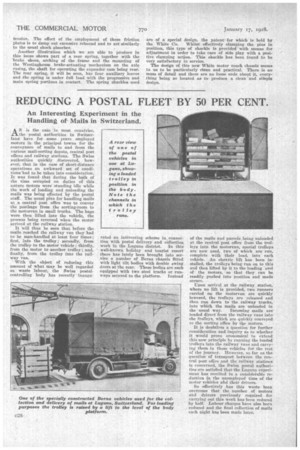REDUCING A POSTAL FLEET BY 50 PER CENT.
Page 50

If you've noticed an error in this article please click here to report it so we can fix it.
An Interesting Experiment in the Handling of Mails in Switzerland.
As is the case in most countries, the postal authorities in Switzerland have for some years employed motors in the principal towns for the conveyance of mails to and from the various mail-sorting depots, central post offices and railway stations. The Swiss authorities quickly discovered, however, that in the case of short-distance operations an awkward set of conditions had to be taken into consideration. It was found that during the bulk of the time occupied on duties of this nature motors were standing idle while the work of loading and unloading the !nails was being effected by the postal staff. The usual plan for handling mails at a central post office was to convey the postbags from the sorting-room to the motorvan in small trucks. The bags were then lifted into the vehicle, the process being reversed when the motor arrived at the railway station.
It will thus be seen that before the mails reached the railway van they had to be man-handled at least four times ; first, into the trolley ; secondly, from the trolley to the motor vehicle ; thirdly, from the motor to another trolley ; and, finally, from the trolley into the railway van,
With the object of reducing this amount of what may he well regarded as waste labour, the Swiss postalcontrolling body has recently inaugu rated An interesting scheme in connection with postal delivery and collection work in the Lugano district. In this well-known holiday and tourist resort . there has lately been brought into service a number of Berna chassis fitted with light tilt bodies with double swing doors at the rear. These bodies are each equipped with two steel tracks or runways secured to the platform. Instead of the mails and parceLs,being unloaded at the central post office from the trolleys into the motorvan, special trolleys are now used, two of which are run, complete with their load, into each vehicle. An electric lift has been installed, the trolleys being run on to this and then lifted by it to the loading revel of the motors, so that they can be readily pushed into position and made secure.
Upon arrival at the railway station, where no lift is provided, two runners carried on the motorvan are quickly lowered, the trolleys are released and then run down to the railway trucks, into which the mails are unloaded in
the usual way. Incoming mails are loaded direct from the railway vans into the trolleys, which are quickly conveyed to the sorting office by the motors.
It is doubtless a question for further consideration and inquiry as to whether it would prove economical to extend this new principle by running the loaded trolleys into the railway vans and carrying them, in those vehicles for the rest of the journey. However, so far as the question of transport between the central post office and the railway stations is concerned, the Swiss postal authorities are satisfied that the Lugano experiment has resulted in a considerable re, duetion in the unemployed time of the motor vehicles ahd their drivers.
So effectively has this waste been overcome that the number of motors and drivers previously required for carrying out this work has been reduced by half. Labour charges have also been reduced and the final collection of mails each night has been made later.












































































































